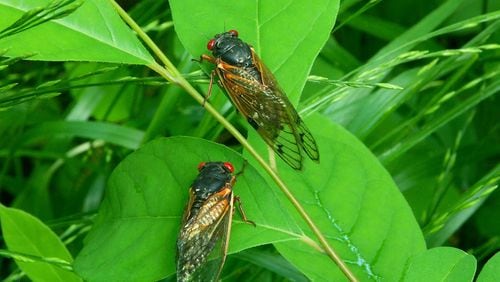You may have heard that a big cicada sexapalooza is about to begin in Georgia.
Well, consider it started. Scattered sightings of the insects or their discarded exoskeletons have been reported recently near Augusta, Macon, Milledgeville, Dahlonega and in Cherokee County.
Millions more could emerge around the state in the coming weeks. They will crawl out of the ground, shed their outer layers, then fly clumsily to nearby trees or bushes, make lots of noise, mate and, soon, die.
There are annual cicadas that appear every summer in Georgia. Periodical cicadas appear in portions of the state every every 13 or 17 years, depending on the group. But the motherload is the Great Southern Brood, which surfaces every 13 years, including this spring. It covers more of the state than any of the other cicadas, and probably in far greater numbers, researchers say.
Still, if you’ve got a hankering to witness the special brood — also known as Brood XIX — you might have to drive a bit. The red-eyed, inch-and-a-half-long bugs aren’t expected to appear in most of metro Atlanta, researchers say.
One potential reason: development. Cutting down trees and spreading asphalt and concrete isn’t good for creatures that spend 12 years and 11 months underground, mostly sucking sap from tree roots, just for the chance to dig their way out for only a few weeks of loud, instinctual mating bliss.
Their activity and noise could peak around Mother’s Day. Before late June all the adults probably will be dead and their hatched offspring will be burrowing in the ground for the next 13-year cycle.
All this can creep out some people.
Not Nancy Hinkle, a University of Georgia entomology professor. She is kind of in cicada heaven.
Cicadas, she acknowledges, don’t fit her job description. She specializes in parasites and other pests that harass or suck the blood of livestock, poultry, wildlife and pets.
Cicadas don’t do such things. They aren’t biters; they’re lovers. (They do eat plants, usually without causing too much damage.)
It wouldn’t be wise to center your academic career on a creature that emerges just once every 13 years, she said. How are you going to do many replicated studies with that kind of gap?
But how can she resist?
“They are just so different. The fact that they can live underground and know when 13 years is up, within six weeks of each other, and they will all emerge. Now, isn’t that impressive?”
Credit: AP
Credit: AP
This year the brood in the Southeast is getting extra attention because it will appear at the same time as another robust group, Brood XIII, in the Midwest. It’s a rare double wallop, fanning feverish talk of an approaching “cicada-geddon,” even though there will be little geographic overlap of the two (and not in Georgia).
In 2011, the last time the Great Southern Brood was out and about, Hinkle chased reports of sightings across the Georgia countryside. She estimated Great Southern Brood cicadas were present in nearly 80 Georgia counties, more than four times as many as reported in 1960, the last such research in the state.
Hinkle suspects that the increase is tied to improvements in gathering reported sightings, rather than a big increase in the range of the insects. In fact, she thinks it likely that urbanization might well be causing a decline in the brood’s presence in Georgia.
The densest populations, she believes, were in Augusta, Columbus, Rome, Macon, Milledgeville, Monticello, Lake Sinclair, and around West Point Lake. Still, although she located them more widely across the state than a federal map shows, the presence of the insects could be patchy. Some might be present on a few acres in one county, but the next group might be miles away, she said.
“I was, frankly, underwhelmed by the numbers that I found. It was exciting. It was fun. It was noisy … but nothing like the drama that was portrayed in the media.”
The call of cicada males trying to attract females sounds “like a motor running off in the distance,” according to Hinkle.
For some, though, the sound and swarm are more jarring.
The arrival of the Great Southern Brood in 1985 forced a family to stop their truck as they drove through a Middle Georgia wildlife refuge, after the odd din they heard made them think the vehicle’s wheel bearings had gone bad, according to an Atlanta Journal-Constitution story at the time. When the brood arose again in 1998, Troup County firefighters responded to numerous 911 calls from worried residents. In one case people suspected a natural gas main had ruptured.
There was a similar rash of 911 calls in Union County in 2021, when a different group of cicadas, Brood X, emerged in some of the state’s northernmost counties. People apparently thought security or fire alarms were going off.
That same year Evan Lampert, an entomologist and professor of biology at the University of North Georgia, threw himself into tracking cicadas.
“The numbers are kind of stupefying,” Lampert said. At a site in Dahlonega that year, he counted 80 members of Brood X in just one square meter.
Exoskeletons stick to tree trunks, houses, fences, bird feeders, anything vertical, really.
And the live creatures?
“They are flying all over the place,” he recalled. “Not like thousands on every plant, but pretty much on every shrub there’s dozens of them.”
And the sound? “Like an old-school science-fiction UFO.”
The cicada coquetry attracts attention from birds and other hungry creatures. “They don’t last long because things eat them up.” When they die near water, “fish go nuts.”
Cats tend to love toying with cicadas. Dogs often like to eat the insects, though chowing too many will make them throw up.
Lampert said he and some of his students will be searching for cicadas this year with various research in mind. When and where will they emerge and for how long? “They are a good indicator of a changing world if we look to see where they expand and contract in their ranges,” Lampert said.
Among other questions they’re trying to answer: Does the shape of their bodies differ in different parts of the state? Do their claws vary by soil type and what does that teach students about evolution?
For metro Atlantans anxious to witness the spectacle, he suggested heading out on a highway in almost any direction from the city’s core. I-75 south to Macon maybe or north to Cherokee or the Calhoun area. I-85 to Habersham or Hart counties. Maybe Rome or Dalton or Columbus.
In the past, people also have included cicadas in cookbook recipes, put them in pizzas and in ice cream.
“They are perfectly edible,” Hinkle said. “I do recommend you catch them when they first emerge.... They are like a soft-shell crab. I recommend removing the legs and wings. Sauté them in garlic butter.”
How the cicada lifecycle works:
Depending on the species, wingless nymph forms of cicadas can live underground feeding on the sap of tree roots for a year, 13 years or 17 years. When they emerge above ground they shed their exoskeletons, which are often found stuck on the sides of tree trunks, and insects take flight to the tops of trees. Males make courting sounds to attract females. After mating, the males soon die. The females lay their eggs under the bark of twigs on trees, then the moms die, too. Within a few days, tiny nymphs, each smaller than a grain of rice, emerge and fall to the ground. They burrow underground to begin a new cycle.
How to tell the difference between periodical cicadas (13- or 17-year) and cicadas that emerge annually during the summer:
If a cicada is above ground before June in Georgia, odds are it is a periodical cicada, according to Nancy Hicks, a professor of entomology with the University of Georgia. She said periodical cicadas have red eyes, black bodies and clear wings highlighted with orange and are often about one and a quarter inch to one and a half inch long, including their wings. Annual cicadas often have black eyes, green bodies and clear wings highlighted with green, and are usually about a half inch longer than periodical cicadas. The courting sounds of different types of cicadas can often differ, too.
Map of different cicada broods and their timing in the United States: https://www.fs.usda.gov/foresthealth/docs/CicadaBroodStaticMap.pdf (This map shows a less-expansive range for Brood XIX in Georgia than what UGA’s Nancy Hinkle has found here.) Source: U.S. Forest Service








